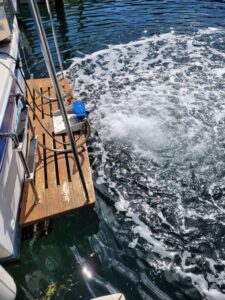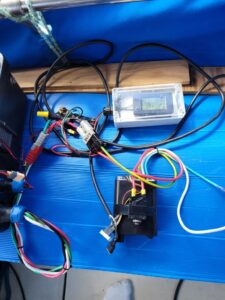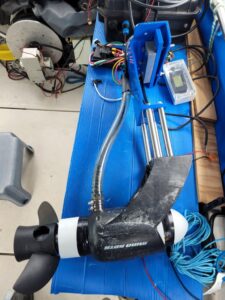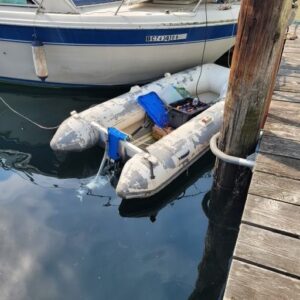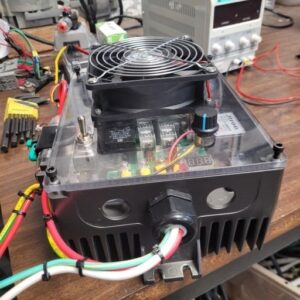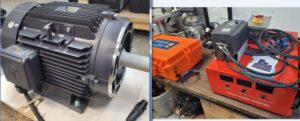September 2023 EV Cris Craft is launched
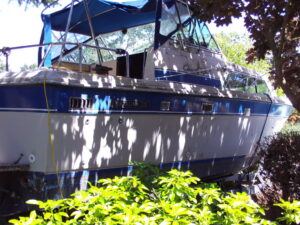
Previously I had a nice 37 foot 1974 Chris Craft for conversion, but it was to large to fit in my driveway at home so I acquired the 28 foot Chris Craft instead.
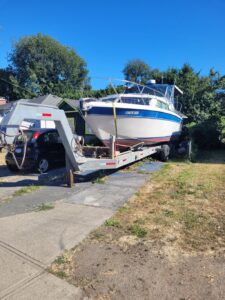
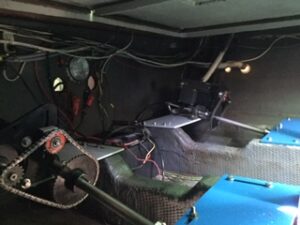
The 3600 RPM, 230 VAC, 3 phase electric motors were coupled to the drive shafts using chains and sprockets. This allows for matching the motor torque to the propeller. The extension shaft has two floating bearings, the shaft connects to the original drive shaft with a coupler. Setting the shaft angle and aligning the shafts was a challenge as I had never done this before. A special mount was fabricated that allows for movement in 3 directions allowing alignment with the sprocket on the extension shaft. Even with the chain drive it is fairly quiet. I used standard 230 VAC Vector drives, powered from two 12KW inverters. There are 3 of 17KW 48 VDC lithium LIPO4 battery packs.
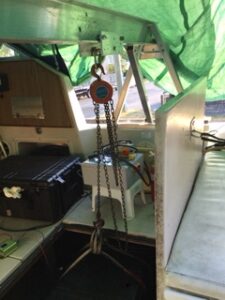
The 3 battery packs helped with the imbalance of weight at the stern but more need to be done.
A pair of joysticks replaced the original controls for the gas engines with two battery displays indicting battery charge and power being used.

For heating I installed a Marine Air 16K BTU system, it takes about 20 minutes to heat the boat from 6 degrees C to 20 degrees C, it runs on 120 VAC about 1400 watts. I did learn a lesson not to use a mercury type thermostat, it goes a bit crazy when you are rocking from waves. Changed to a micro-switch based thermostat for the winter, it works well. I am presently using a Princes Auto water pump to supply the seawater to the heat-pump. It works very well and is cost effective, but to me it seems noisy so I am looking for an alternative.
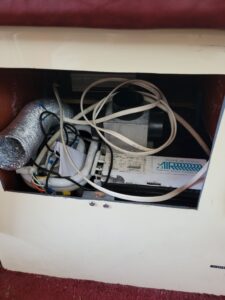
I have also removed all propane devises using an electric stove and an electric barbeque. This now makes the boat fully electric.
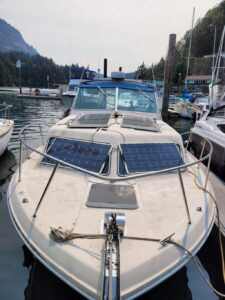
Up dated as of May 25 2024
At this time I have 1500 watts of solar panels charging 6 battery packs including the house battery, dingy and 3rd motor battery packs. I also have 120 VAC plug in capability for shore power as an optional charging capability. I plan on upgrading the panels as efficiency of panels increases. Since I only use the boat on weekends this seems just fine.
Special thanks to Ian Soutar of Esquimalt, for donating a pair of large solar panels for recharging the batteries that are powering the boat.
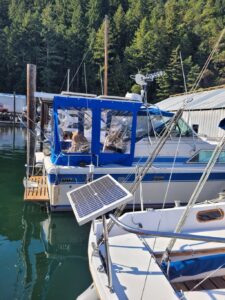
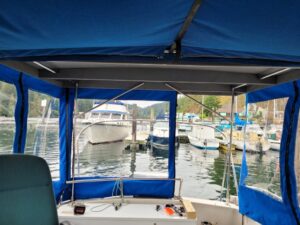
The new roof and canvas make it easier to heat the cabin plus gives a nice sun room during the cool fall days.
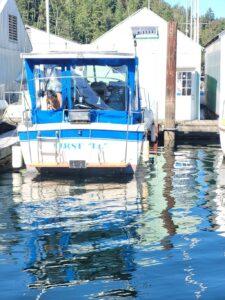
Estimated range of 100 to 120 Km with a top speed of 6 to 7 miles per hour. As soon as good weather returns in the spring sea trials will begin to confirm my calculations.
A nice option with the power packs was we were able to charge a Leaf car both level one and two.
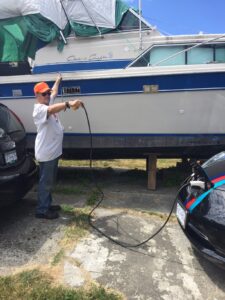
Also with a smaller 4.5kw 36 VDC portable pack, we used it in the summer to power the EV dingy 3 Hp 230 VAC motor and in the winter it is in my IMIEV car to power an optional Canadian Tire 120 VAC ceramic heater. Works out better than original heating system plus I do not loose any range.

May 19 2024
Using the same 36 Volt lithium 125 amp hr pack will be powering a third modified backup 2 hp Min Kota trolling motor on the aft of the boat.
Modified Min Kota with 4 variable pitch blades
Have to add 6 inches more depth for motor
36 volt battery to left, 100 amp current and power meter top center, 60 amp 100 volt variable speed controller for motor since original controller shuts down with the loading from the variable propeller.
May 26 2024
Added 6 inch stainless extensions rods to get more depth.
Sept 05: Zinc spray coating motor as anti fouling.
Mounted modified 2 Hp 36 VDC Min Kota with variable pitch set to 4 inches.
Using the 12 volt lithium pack took system for a short run, needed ruder before using 36 volt battery. The motor controller a 100 amp max 60 amp continuous had many problems so modified with fan, up graded to 300 volt fets 30 amps. So far it has not burnt up again, at 12 volts max current was 20 amps, maybe when I go with the 36 volt power source. Already had the relays burn at 35 amps previously.
October 2024: An unexpected problem
After a year of not running the system, I was having a system overload issues. Using my underwater survey system I identified the problem. A massive build up of muscles covering both rudders and drive systems jamming the drives. Almost nothing on the rest of the bottom, action to be taken. Next time I will run the system at least once every 2 weeks, a suggestion that the gas boaters do to keep the muscles off. Along with a zinc spray paint that I used on the bottom of the dingy. I will also be testing out a new anti-fouling titanium additive coating for Dr. Rodney Herring.
Before seeing the muscle problem, I put together a drop in 10 horsepower drive system. Testing of this system had no big problems. with a few small changes the original batteries will run the new drive. System is made up of a 7.5Kw 3 phase VFD, an aluminum 10 Hp, 3 phase 230 Volt AC 115 lbs C-motor, heaver Anderson connectors and 200 amp voltage/current monitor as a direct drop in display that is presently being used. I am also using a 10Kw 48 VDC to 208 Volt AC 3 phase inverter with a 20Kw surge capability.
Sept 2024: The Miles EV van was overhauled with lithium batteries and a solar charging system. It now has a range of about 120 Km. Nice to see that it is on the road and not part of the boats drive system. Good job done by Tom the EV car battery repair man.
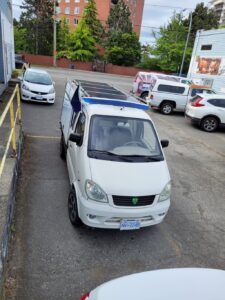
13/08/2018 – 2HP Electric Outboard conversion
02/02/2018 – Phase 3 – Update
22/10/2017 – Phase 3
Addition of a 16000BTU HVAC system. Due to the high efficiency of the heat pump this is the ideal option for an all electric boat. It’s being powered by a Solar Inverter System. With an external temperature of 8 to 9C it heats up the whole cabin to 20C is less than 15 minutes.
20/08/2017 – Phase 2
15/08/2017 – Phase 1
15/01/2017
As of January 15, we have three drive systems under consideration.
- The Mars motor outboard motor (36 to 48 VDC) or Minn Kota thruster (36V), that could be mounted to the transom.
Minn Kota Electric Outboard MARS motor outboard - The 3 phase 208 VAC 5 or 8 hp. Electric motors powered from the 48 VDC 3 phase inverter with Vector drive controller and joystick.
- We have acquired a 2009 Miles 72 VDC EV van to evaluate removing it’s drive train and batteries to mount in the boat. It used AC motors that are paired to Curtis-Albright AC Motor Controllers.
New Stage of the project – 28/10/2016
For this new stage we’re going to do the electric conversion of a Chris-Craft boat with a combustion engine. The conversion will include several solar panels, a battery bank, a VFD controlled 7.5HP AC Electric motor and a 10kW 208VAC 3 Phase Power Inverter. A heat pump will also be added at a later stage.
AGO Fuel Cells and the parent company A.G.O. Environmental Electronics Ltd are conducting privately-funded experimental research projects into the development of an EV boat built using a 1980 35 foot 10 ton steel motor sailor. One of the key components of this build will be the inclusion of the Sinopoly Battery International Limited’s 100 amp hr lithium battery bank.
The photo below is the 36 volt 100 amp hr. Sinopoly Battery Limited lithium battery pack model SP-LFP100AHA used for this test. It can be charged with its 115 VAC plugin line charger or via its Zahn 250 Watt DC to DC solar charger. Both chargers cut out at 41.2 VDC with current limiting of 10 amps max.
Please see battery data sheet for details.

Sept. 7/2013 using a Mars DC motor and converting a 9.9 Honda to electric along with
100 amp hr. lithium battery pack response testing of the boat were conducted.
| Speed in Knots | Current | Voltage | Watts | Hp. |
| 3.0 K | 90 amps. | 35.5 volts | 3195 | 4.26 |
| 3.1 K | 107 | 35.5 | 3798 | 5.06 |
| 3.6 K | 165 | 34.5 | 5693 | 7.59 |
| 3.9 K | 300 | 32 | 9600 | 12.8 |
The results indicate that a 5 horsepower 230 VAC Vector drive system will be satisfactory for our application.
The Mars motor outboard Honda conversion is for sale as well for $ 1,500.
EV Mars DC 8 to 15 hp./9.9 Honda electric conversion

We are always looking for partners and interested parties regarding these development projects and welcome contacts and questions regarding these projects and others you may have.
2009
There are a number of systems improvements that we plan to undertake for next season in the area of high-pressure hydrogen storage tanks, ultra-capacitors in place of batteries and electro-mechanical layout. Since we are now able to supply substantial amounts of power from 12 volts D.C. through to 240 volts 3 phase AC we are evaluating such applications as forced air heating, a heat pump system and a portable emergency water and power module for disaster applications.
2007
We sailed to Goldstream in the fall of 2007, in the sloop “Jim D”, which was assisted with a Horizon H300 fuel cell. After an evaluation of the trip, we estimated that the electric motor powering the boat needed to be in the range of 2 to 4 horsepower. As off the shelf solutions were not immediately evident, the plan to modify a Yamaha motor from gas to electric was conceived.
The design was based on available technologies that were easily combined and affordable. The first system was deployed in early June on Ian Soutar’s 18-foot cabin cruiser, “Pepper Pot”. It was on display with the sloop “Jim D” at the Tall Ship Festival in Victoria. The “Jim D” had been fitted with a Minn Kota, model RT202/EM, a 4 horsepower dual electric motor system capable of producing over 200 pounds of thrust. This was a 36 VDC, 98-amp unit that required an even larger fuel cell system than we had originally planned.
YouTube Video
In an attempt to accelerate our development plan, we became involved with the Mechatronics program at the University of Victoria. A group of 5 fourth year mechanical and electrical engineering students undertook the development of a dual 1.2-kilowatt fuel cell system along with finalizing the Yamaha conversion kit. In mid August, a working prototype was ready for deployment. The resulting architecture was even better than we had expected, allowing the operation of up to 4 parallel fuel stacks by one master controller. This would allow for redundancy in the system and permit up to 4.8-kilowatts of power at a much reduced cost.
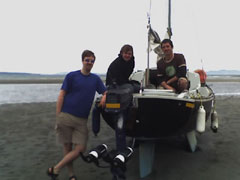
While the pair of 1.2-kilowatt fuel cells were being worked on at the University and using the B.C government carbon tax refund, the boat was outfitted with 35 watts of Canadian Tire solar panels. They provided sufficient power for local operations of the Jim D on a daily basis. During this period of testing, it was found that only one of the RT202/EM motors was required for the boat to reach a maximum speed of 4 miles per hour, the speed being limited by the 4-inch pitch of the propeller. It was also established that only 550 to 600 watts of power was required to maintain this speed for extended periods of time. As a result, the fuel cell system was trimmed back to a single Palcan PC5, 1.2-kilowatt fuel cell stack.

September and October has seen continued testing of the combination fuel cell/solar power system with very satisfactory results. My appreciation to Palcan for all of their technical assistance and to the Selkirk Station Kayak and Bike for supplying hydrogen this year.
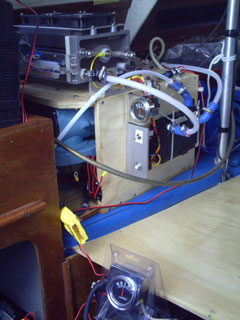
In May of this year, I purchased 40 litres of gasoline for the sailboat and after some 150 miles and 5 months of use, I still have about 30 to 35 litres left. The gasoline is used as ballast to help keep the electric motor portion of the gas/ electric hybrid outboard motor under the surface of the water. The other benefit of using only one of the electric motors is that the weight reduction has made it easer to manually lift the outboard into its normal out of water storage position.

As a result of seeing the news stories about Canada’s first fuel cell assisted sailboat, the Alumni Association of Loyalist College, Belleville Ontario has nominated me for this year’s Ontario Premiers Award for Technology. I will also receive the “Best Innovation Award” from the Esquimalt Chamber of Commerce at the Annual General Meeting, November 19, 2008. I wish to thank those involved for these honors.

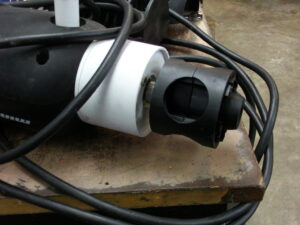
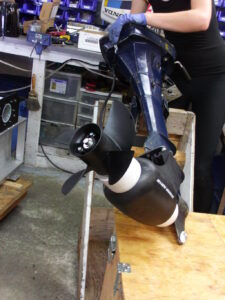
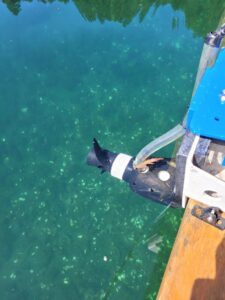 I modified the motor by adding a variable pitch propellar along with sealing the electrical connection with tubing and Scotch coat sealer
I modified the motor by adding a variable pitch propellar along with sealing the electrical connection with tubing and Scotch coat sealer